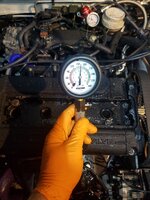spyderdrifter
10+ Year Contributor
- 5,268
- 711
- Jul 11, 2009
-
Somewhere in,
Colorado
I'm posting this since currently, the search options seem to be broken and I can't search anything. Anyway, I ran a dry compression test just to get a basis of my engine's health. The results were as follows:
Cyl 1: 147 psi
Cyl 2: 143 psi
Cyl 3: 100 psi
Cyl 4: 150 psi
From there, you can all see the problem. But there's more. I didn't do a wet test, because I don't think cyl 3's reading is accurate. The other 3 cylinders are well within spec of one another, and they were higher than I had assumed they'd be, so I'm happy with those. However, while cranking the car over, cyl 3 would make a popping sound and wouldn't go above 100 psi. Every time yielded the same result with no variations. The only thing is I don't remember if the pop came before or after hitting 100 psi. I failed to note that. The car's power has been pretty good, but still at times it does kind of feel like it falls short. Not always, but on rare occasion. I don't know where this pop noise came from, and have no idea what could be causing it. The only idea I've been able to come up with, is if the pop happens right when it hits 100 psi, could one of the injector seals be popping and then re sealing? However, there's no leaking once it hits 100, and just simply won't go higher either. I'm a little lost on this one. The engine was warm as I had just returned fro ma test drive, and the only thing I forgot to do was open the throttle plate. Injectors were all unplugged and the plug wires were all pulled from the coils.
Cyl 1: 147 psi
Cyl 2: 143 psi
Cyl 3: 100 psi
Cyl 4: 150 psi
From there, you can all see the problem. But there's more. I didn't do a wet test, because I don't think cyl 3's reading is accurate. The other 3 cylinders are well within spec of one another, and they were higher than I had assumed they'd be, so I'm happy with those. However, while cranking the car over, cyl 3 would make a popping sound and wouldn't go above 100 psi. Every time yielded the same result with no variations. The only thing is I don't remember if the pop came before or after hitting 100 psi. I failed to note that. The car's power has been pretty good, but still at times it does kind of feel like it falls short. Not always, but on rare occasion. I don't know where this pop noise came from, and have no idea what could be causing it. The only idea I've been able to come up with, is if the pop happens right when it hits 100 psi, could one of the injector seals be popping and then re sealing? However, there's no leaking once it hits 100, and just simply won't go higher either. I'm a little lost on this one. The engine was warm as I had just returned fro ma test drive, and the only thing I forgot to do was open the throttle plate. Injectors were all unplugged and the plug wires were all pulled from the coils.
Last edited:



















